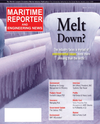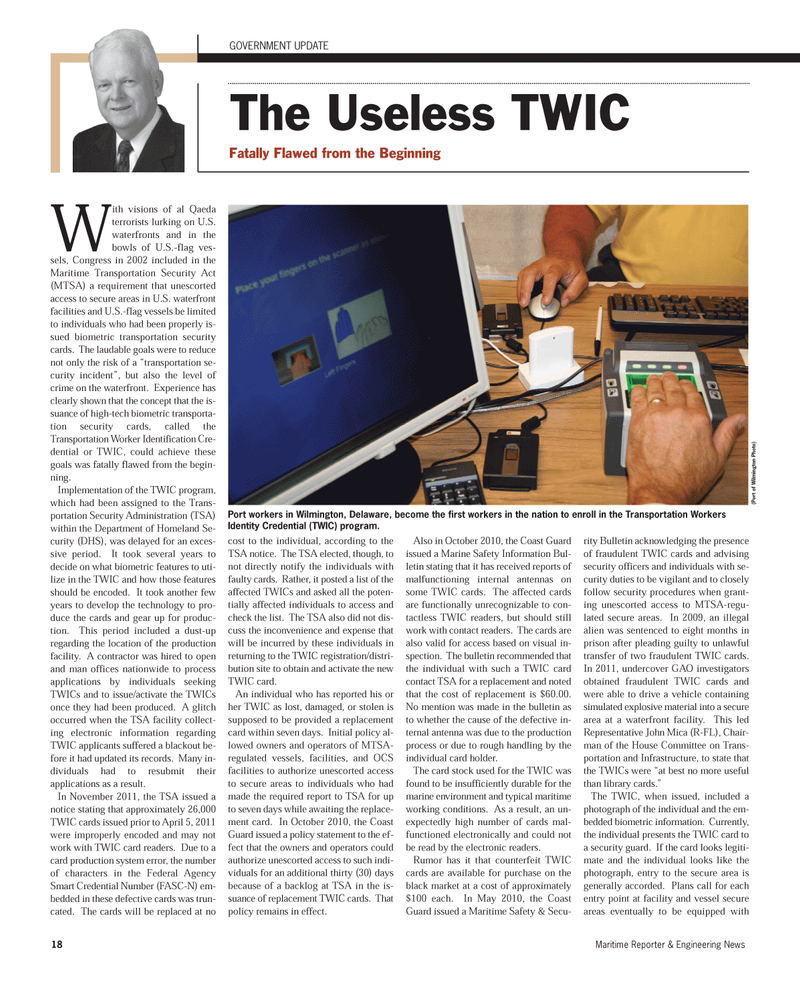
Page 18: of Maritime Reporter Magazine (May 2012)
The Green Ship Edition
Read this page in Pdf, Flash or Html5 edition of May 2012 Maritime Reporter Magazine
18Maritime Reporter & Engineering News With visions of al Qaedaterrorists lurking on U.S.waterfronts and in the bowls of U.S.-flag ves- sels, Congress in 2002 included in theMaritime Transportation Security Act (MTSA) a requirement that unescortedaccess to secure areas in U.S. waterfront facilities and U.S.-flag vessels be limited to individuals who had been properly is- sued biometric transportation securitycards. The laudable goals were to reduce not only the risk of a ?transportation se-curity incident?, but also the level of crime on the waterfront. Experience has clearly shown that the concept that the is- suance of high-tech biometric transporta-tion security cards, called theTransportation Worker Identification Cre- dential or TWIC, could achieve these goals was fatally flawed from the begin- ning.Implementation of the TWIC program, which had been assigned to the Trans- portation Security Administration (TSA) within the Department of Homeland Se-curity (DHS), was delayed for an exces- sive period. It took several years to decide on what biometric features to uti-lize in the TWIC and how those features should be encoded. It took another few years to develop the technology to pro- duce the cards and gear up for produc-tion. This period included a dust-up regarding the location of the production facility. A contractor was hired to open and man offices nationwide to process applications by individuals seeking TWICs and to issue/activate the TWICs once they had been produced. A glitch occurred when the TSA facility collect- ing electronic information regarding TWIC applicants suffered a blackout be- fore it had updated its records. Many in- dividuals had to resubmit their applications as a result.In November 2011, the TSA issued a notice stating that approximately 26,000TWIC cards issued prior to April 5, 2011 were improperly encoded and may notwork with TWIC card readers. Due to a card production system error, the number of characters in the Federal Agency Smart Credential Number (FASC-N) em- bedded in these defective cards was trun- cated. The cards will be replaced at no cost to the individual, according to the TSA notice. The TSA elected, though, to not directly notify the individuals with faulty cards. Rather, it posted a list of the affected TWICs and asked all the poten- tially affected individuals to access and check the list. The TSA also did not dis- cuss the inconvenience and expense that will be incurred by these individuals in returning to the TWIC registration/distri- bution site to obtain and activate the new TWIC card.An individual who has reported his or her TWIC as lost, damaged, or stolen is supposed to be provided a replacement card within seven days. Initial policy al- lowed owners and operators of MTSA- regulated vessels, facilities, and OCS facilities to authorize unescorted access to secure areas to individuals who had made the required report to TSA for up to seven days while awaiting the replace- ment card. In October 2010, the CoastGuard issued a policy statement to the ef- fect that the owners and operators could authorize unescorted access to such indi-viduals for an additional thirty (30) daysbecause of a backlog at TSA in the is- suance of replacement TWIC cards. That policy remains in effect. Also in October 2010, the Coast Guardissued a Marine Safety Information Bul-letin stating that it has received reports of malfunctioning internal antennas onsome TWIC cards. The affected cards are functionally unrecognizable to con-tactless TWIC readers, but should still work with contact readers. The cards are also valid for access based on visual in- spection. The bulletin recommended that the individual with such a TWIC card contact TSA for a replacement and noted that the cost of replacement is $60.00.No mention was made in the bulletin as to whether the cause of the defective in- ternal antenna was due to the production process or due to rough handling by theindividual card holder. The card stock used for the TWIC was found to be insufficiently durable for the marine environment and typical maritime working conditions. As a result, an un- expectedly high number of cards mal- functioned electronically and could notbe read by the electronic readers. Rumor has it that counterfeit TWIC cards are available for purchase on the black market at a cost of approximately $100 each. In May 2010, the CoastGuard issued a Maritime Safety & Secu-rity Bulletin acknowledging the presence of fraudulent TWIC cards and advising security officers and individuals with se- curity duties to be vigilant and to closelyfollow security procedures when grant- ing unescorted access to MTSA-regu- lated secure areas. In 2009, an illegal alien was sentenced to eight months in prison after pleading guilty to unlawful transfer of two fraudulent TWIC cards. In 2011, undercover GAO investigators obtained fraudulent TWIC cards and were able to drive a vehicle containing simulated explosive material into a secure area at a waterfront facility. This led Representative John Mica (R-FL), Chair- man of the House Committee on Trans- portation and Infrastructure, to state thatthe TWICs were ?at best no more useful than library cards.? The TWIC, when issued, included a photograph of the individual and the em- bedded biometric information. Currently, the individual presents the TWIC card to a security guard. If the card looks legiti- mate and the individual looks like the photograph, entry to the secure area isgenerally accorded. Plans call for eachentry point at facility and vessel secure areas eventually to be equipped with GOVERNMENT UPDATE The Useless TWICFatally Flawed from the Beginning (Port of Wilmington Photo) Port workers in Wilmington, Delaware, become the first workers in the nation to enroll in the Transportation Workers Identity Credential (TWIC) program. MR May 12 # 3 (17-24):MR Template 4/27/2012 11:07 AM Page 18

 17
17

 19
19
